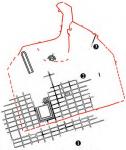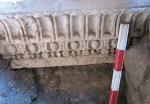Summary (English)
PHILIPPOPOLIS (Elena Bozhinova – elena.bozhinova@gmail.com) The site was situated at the southern foot of Dzhambaz Tepe Hill. An area of 7 sq. m was explored down to 3.50 m in depth. Four partly preserved Christian graves were discovered, belonging to a cemetery of the 17th – 19th centuries that existed there. A stratum of the 12th century was documented and part of a wall was discovered with foundation built in rubble masonry and upper part of sun-dried bricks. The stratum of the 12th century was situated over the remains of a monumental building with several construction phases. A wall belonging to the earliest construction phase was discovered, 1.55 m wide and built of bricks (30 cm by 30 cm in size) bonded with mortar. A cornice in Ionic order was incorporated on its western side, decorated with Ionic cyma and acanthus leaves and dated to AD 150 – 175. A mortar plaster of a marble veneer was preserved on the wall under the cornice. A niche was situated above the cornice and it was walled during a later construction phase. The wall belonged to public baths, parts of which were discovered during excavations in 1946 and 1996. The baths covered an area of over 0.25 ha and were situated in more than one insula. They were built in AD 250 – 300 over an earlier monumental building, probably public baths as well. The architectural complex was burned at the end of the 4th – first half of the 5th century AD and subsequently it was partly reconstructed. The baths were finally destroyed by a fire at the end of the 6th – beginning of the 7th century AD. During a later construction phase, another wall was built adjoining the western side of the earlier one with the cornice. The later wall had foundation built in rubble masonry and upper part of sun-dried bricks and probably dated to the 5th – 6th centuries AD.
- Elena Bozhinova - Archaeological Museum - Plovdiv
Director
Team
Research Body
- Archaeological Museum – Plovdiv






![Download [PDF]](/excavation/skins/fasti/images/results/download_sml.png)
